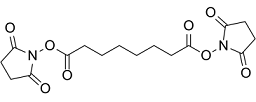All AbMole products are for research use only, cannot be used for human consumption.

DSS Crosslinker (Disuccinimidyl suberate) is a non-cleavable, cell membrane permeable ADC linker used in the synthesis of antibody-drug conjugates (ADCs). DSS crosslinker has amine-reactive NHS esters at both ends of an 8-atom (11.4 angstrom) spacer arm that are used to conjugate proteins. DSS crosslinker can be used to conjugate or crosslink intracellular proteins.
DSS Crosslinking Protocol
1. Allow vial of DSS Crosslinker to fully equilibrate to ambient temperature before opening to prevent condensation inside the vial (DSS is moisture-sensitive).
2. Prepare a 50 mM solution of DSS, by dissolving 10 mg DSS in 540 µL of dry DMSO or dry DMF.
3. Using a 20-fold excess approach (20:1 Crosslinker:Protein), add crosslinker solution to the protein sample in non-amine containing buffer (i.e. 25 mM Sodium Phosphate, pH 7.4), so that the final crosslinker concentration is between 0.5 to 5 mM. Optimal pH range is from 7 to 9. The DSS solution may become slightly hazy in an aqueous mixture.
4. Allow the sample to react at room temperature for 45 minutes to 1 hour. Allow slightly longer if sample must be kept on ice (recommended 2-3 hours). This reaction rate is not highly temperature sensitive.
5. Quench any unreacted DSS with 25 mM to 200 mM Tris, pH 7.4 and allow to react for 10-15 minutes at room temperature.
6. Desalt sample to remove residual crosslinker (i.e. gel filtration or dialysis, etc.)
| Molecular Weight | 368.34 |
| Formula | C16H20N2O8 |
| CAS Number | 68528-80-3 |
| Solubility (25°C) | DMSO ≥ 90 mg/mL chloroform 50 mg/mL |
| Storage |
Powder -20°C 3 years ; 4°C 2 years In solvent -80°C 6 months ; -20°C 1 month |
| Related Drug-Linker Conjugates for ADC Products |
|---|
| MC-SN38
MC-SN38 is a agent-linker conjugate composed of a potent microtubule-disrupting agent SN38 and a non-cleavable MC linker to make antibody agent conjugate (ADC). |
| DM4-SMCC
DM4-SMCC is a agent-linker conjugate for ADC with antitumor activity by using DM4 (an antitubulin agent), linked via the non-cleavable SMCC linker. |
| Lys-SMCC-DM1
Lys-SMCC-DM1 (Lys-Nε-MCC-DM1) is a agent-linker conjugates for ADC that can inhibit tubulin polymerization. |
| Doxorubicin-SMCC
Doxorubicin-SMCC is a agent-linker conjugate for ADC. |
| Mal-PEG4-VC-PAB-DMEA-PNU-159682
Mal-PEG4-VC-PAB-DMEA-PNU-159682, a agent-linker conjugate for ADC, consists the ADC linker Mal-PEG4-VC-PAB and a potent ADC cytotoxin DMEA-PNU-159682. |
All AbMole products are for research use only, cannot be used for human consumption or veterinary use. We do not provide products or services to individuals. Please comply with the intended use and do not use AbMole products for any other purpose.


Products are for research use only. Not for human use. We do not sell to patients.
© Copyright 2010-2024 AbMole BioScience. All Rights Reserved.
